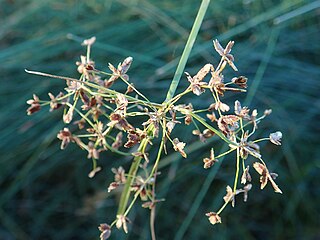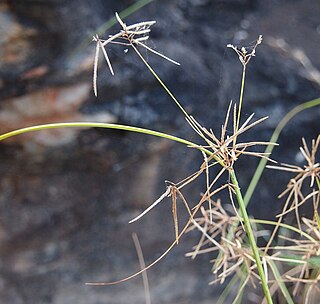
Cyperus polystachyos, also known as Pycreus polystachyos, and also called manyspike flatsedge in the US, or bunchy sedge, coast flatsedge, many-spiked sedge or Texas sedge in Australia, is a herbaceous species in the family Cyperaceae, widespread in tropical and subtropical areas around the world, sometimes extending its range into temperate regions.
Cyperus aquatilis is a sedge of the family Cyperaceae that is native to Australia and New Guinea.
Cyperus astartodes is a sedge of the family Cyperaceae that is native to northern parts of Australia.

Cyperus betchei is a sedge of the family Cyperaceae that is native to Australia.
Cyperus blakeanus is a sedge of the family Cyperaceae that is native to Australia.
Cyperus castaneus is a sedge of the family Cyperaceae that is native to parts of northern Australia, southern Africa, India and south east Asia.
Cyperus centralis is a sedge of the family Cyperaceae that is native to arid areas of central Australia.

Cyperus concinnus is a sedge of the family Cyperaceae that is native to Australia, and found in New South Wales, Queensland, the Northern Territory, South Australia, Victoria and Western Australia.
Cyperus cracens is a sedge of the family Cyperaceae that is native to northern and north western parts of Australia.
Cyperus cunninghamii is a sedge of the family Cyperaceae that is native to Australia.

Cyperus dactylotes is a sedge of the family Cyperaceae that is native to all of mainland Australia except for Victoria.
Cyperus digitatus, also known as finger flatsedge in the United States, and chang xiao sui suo cao in China, is a sedge of the family Cyperaceae that is native to tropical and subtropical areas of Africa, Asia, the Americas and Australia.
Cyperus hesperius is a sedge of the family Cyperaceae that is native to Australia.
Cyperus latzii is a sedge of the family Cyperaceae that is native to Australia, and found in the Northern Territory and Western Australia.
Cyperus nutans is a sedge of the family Cyperaceae that is native to Australia, China, India, Bangladesh, south-east Asia, Malaysia, India, and Indonesia.
Cyperus orgadophilus is a sedge of the family Cyperaceae that is native to Australia, in Western Australia, the Northern Territory, and Queensland.
Cyperus portae-tartari is a sedge of the family Cyperaceae that is native to Australia, and found in the Northern Territory and Western Australia.

Cyperus vaginatus, commonly known as stiff-leaf sedge or stiff flat-sedge, is a sedge of the family Cyperaceae that is native to Australia.
Cyperus viscidulus is a sedge of the family Cyperaceae that is native to north western Australia.
Cyperus vorsteri is a sedge of the family Cyperaceae native to southern Africa.




